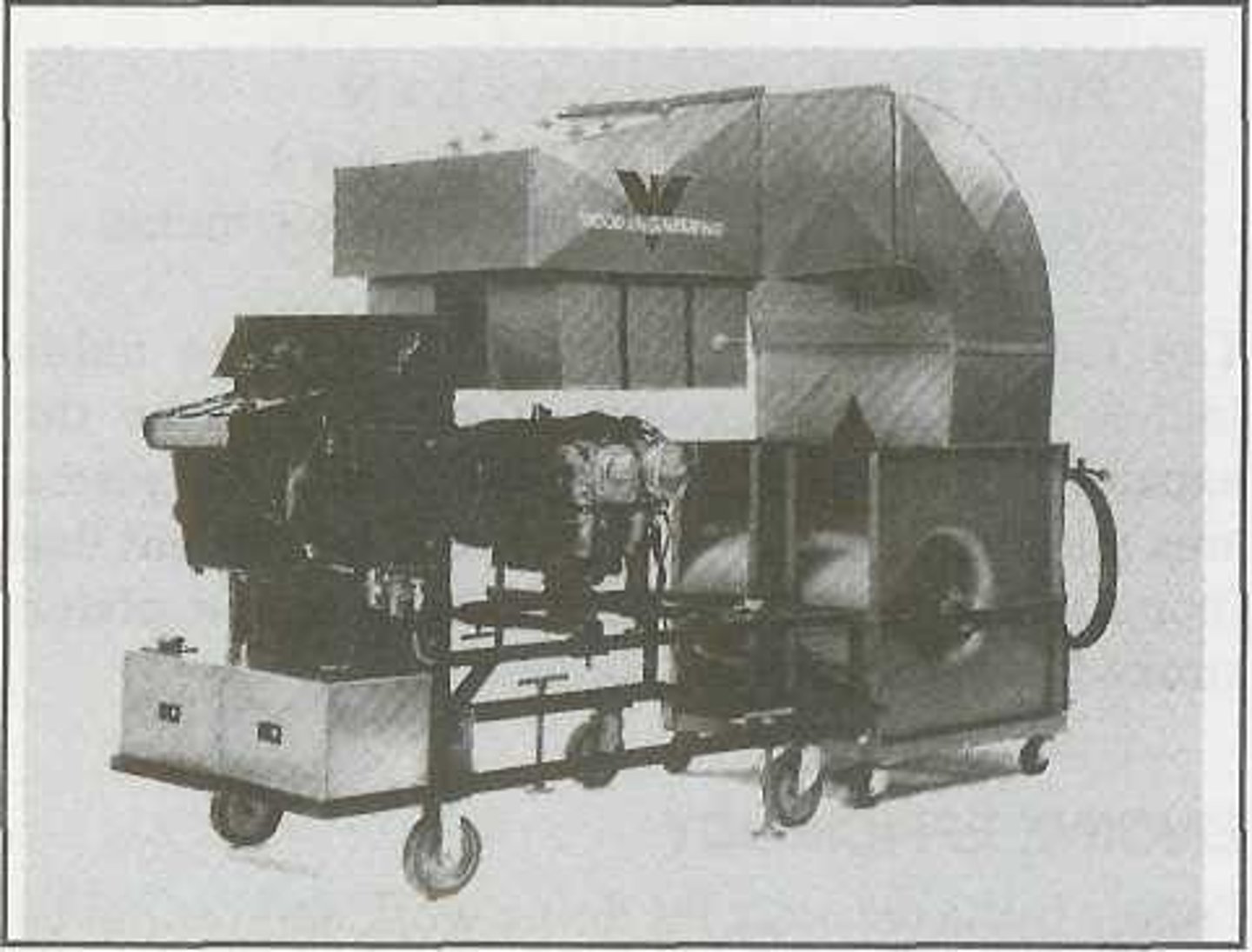Jeppesen 01B - Reciprocating Engines (Operating Principles)
1/194
There's no tags or description
Looks like no tags are added yet.
Name | Mastery | Learn | Test | Matching | Spaced |
|---|
No study sessions yet.
195 Terms
Heat engine
An aircraft engine is a form of ________ that converts the chemical energy of fuel into heat energy.
Internal combustion engine
When fuel used to produce heat is burned inside the engine, an engine is referred to as?
External combustion engine
When fuel is burned outside an engine to produce mechanical energy, the engine is referred to as?
Steam engine
It is the best example of an external combustion engine.
Low cost fuels required to operate an external combustion engine.
Since external combustion engines do not effectively convert the heat provided by the fuel into work, they are relatively inefficient. This offset is somewhat compensated by:
External combustion engine
This combustion engine remain a viable alternative for applications such as electrical powerplants.
Intake
Fuel and air are drawn into a cylinder when the intake valve opens and the piston travels downward.
Compression
The fuel-air mixture is compressed in the cylinder by the upward motion of the piston.
Ignition
Once compressed, the fuel-air mixture is ignited by a spark.
Power
The burning gases expand and force the piston downward which, in turn, rotates the crankshaft to produce work.
Exhaust
The burned gases are scavenged and forced out of a cylinder through the exhaust port as the piston moves upward a second time. Once the piston reaches the top of the cylinder, the sequence is repeated.
Intake, compression, ignition, power, exhaust
One cycle represents one complete series of events that an internal combustion engine goes through to produce mechanical energy. One cycle includes the following events:
Four-stroke (Otto) cycle and two-stroke cycle
What are the two operating cycles in general use today?
Stroke
It is simply the total distance a piston travels between the outward and inward limits within a cylinder.
Top dead center (TDC)
In a cylinder, the most outward limit is referred to as?
Bottom dead center (TDC)
In a cylinder, the most inward limit is referred to as?
180
One stroke is equivalent to the distance a piston head travels between bottom dead center and top dead center. In all reciprocating engines, one complete stroke occurs with each _____ degrees of crankshaft rotation.
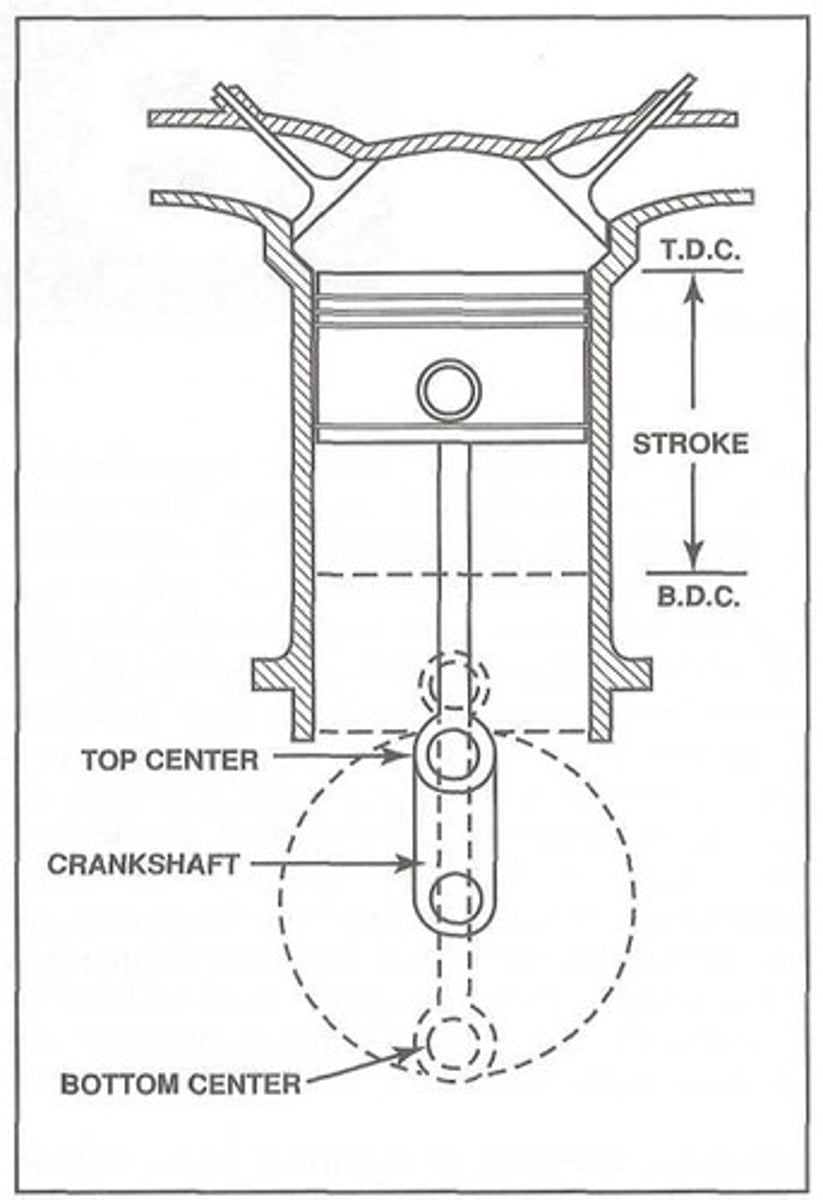
Four-stroke (Otto) cycle
This cycle consists of four strokes, intake, compression, power, and exhaust.
2
One complete four-stroke cycle requires ____ revolutions of the crankshaft.
Constant volume cycle
The four-stroke cycle is sometimes referred to as a ________ because the burning fuel inside the cylinder increases the gas pressure with almost no change in volume.
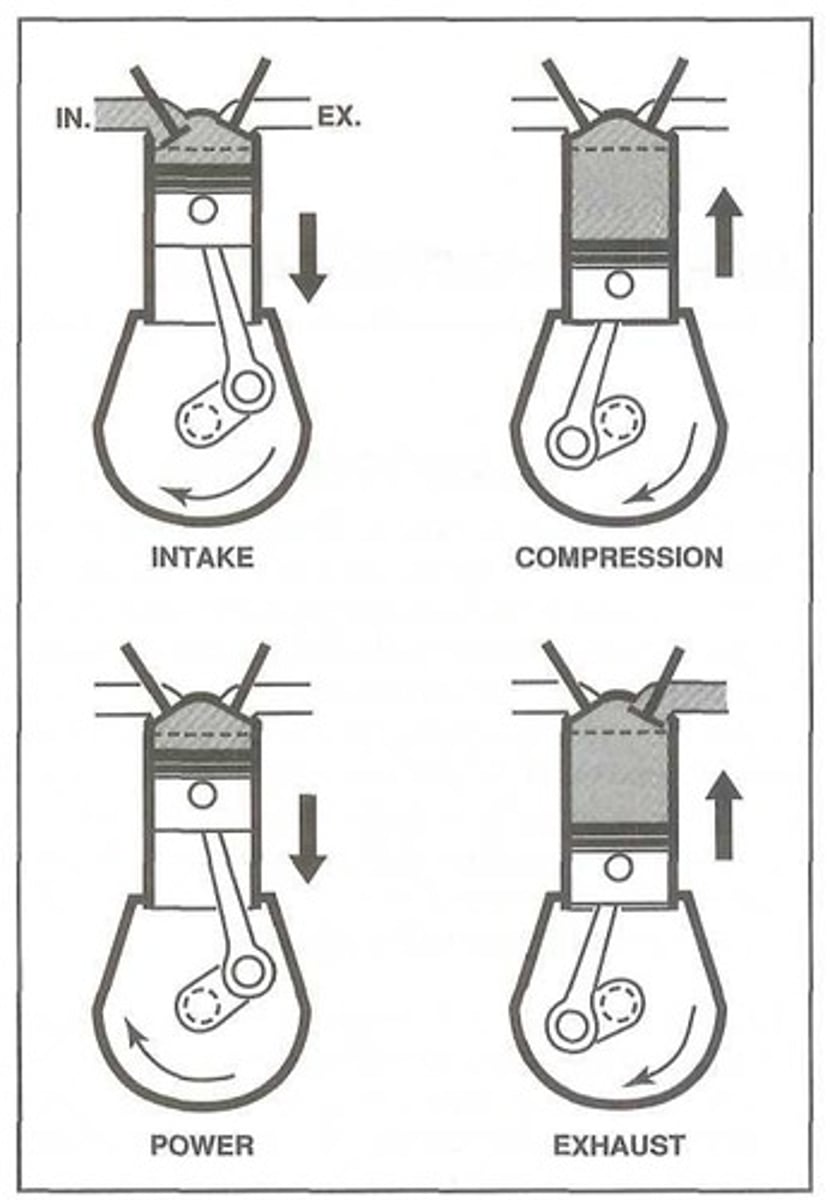
Crankshaft position.
In the four-stroke cycle, the exact timing of when the valves open and close and when ignition occurs varies considerably among engine types. However, timing is always determined by _______.
Degrees of rotation
The timing of each event is specified in terms of crankshaft position, and is measured in _________.
Intake
This stroke begins with the piston at top dead center and the intake valve open.
Intake
During this stroke, crankshaft rotation pulls the piston downward thereby reducing the pressure within the cylinder. Lower pressure inside the cylinder allows air that is under atmospheric pressure to flow through the carburetor where it is mixed with the correct amount of fuel. The resulting fuel/air mixture then passes through an intake manifold pipe, down through an intake port, and past an intake valve into the cylinder.
Throttle position
The quantity, or weight, of fuel and air that enters the cylinder is determined by the _________.
Compression
Once a piston reaches bottom dead center on the intake stroke, the piston reverses direction and begins what stroke?
Allows the momentum of the incoming gases to charge the cylinder more completely.
Depending on the specific engine, the intake valve typically closes about 50 to 75 degrees past bottom dead center on the compression stroke. What happens when the closing of the intake valve until the piston is past bottom dead center is delayed?
Spark plugs
After the intake valve closes, the piston's continued upward travel compresses the fuel/air mixture to obtain the most favorable burning characteristics. As the piston approaches top dead center, the mixture is ignited by an electric spark provided by two _______ installed in each cylinder head.
Complete combustion and maximum pressure are ensured when the piston begins the power stroke.
The exact time ignition occurs varies depending on the requirements of the specific engine, but is typically from 20 to 35 degrees before top dead center. What happens by igniting the mixture before the piston reaches top dead center?
Manufacturer
Who determines the optimum ignition point for each engine model?
Power
As a piston moves through top dead center on the compression stroke, it reverses direction again to begin what stroke?
Power
During this stroke, the piston is pushed downward by the rapidly expanding gases within the cylinder. The temperature of these gases can exceed 3,000 degrees Fahrenheit while pushing down on the piston with a force in excess of 15 tons. However, as the burning gases expand, they cool considerably, exiting the cylinder at a reasonable temperature.
To drive a propeller or a gear case.
The linear motion produced by the back and forth movement of a piston is converted to rotary motion through the use of a connecting rod and crankshaft. The rotary motion is then used ______.
Well before bottom dead center on the power stroke while there is still pressure in the cylinder.
To aid in scavenging the exhaust gases out of a cylinder, when does the exhaust valve open?
Dilute the incoming fuel/air charge during the subsequent intake stroke.
Proper exhaust gas scavenging is an important consideration in engine design since any exhaust products remaining in a cylinder will what?
Excessive engine vibration.
The rapid burning of a fuel/air charge in an engine produces a power impulse. What may occur when an engine is designed with uneven or widely spaced power impulses?
Exhaust
As a piston travels through bottom dead center on the power stroke and starts upward on an ______ stroke, it begins to expel the burned exhaust gases out the exhaust port.
Before top dead center, on the exhaust stroke.
The speed at which exhaust gases leave a cylinder tends to cause the pressure within the cylinder to drop, leaving an area of low pressure. This low pressure speeds the flow of fuel and air into the cylinder as the intake valve begins to open. In order to maximize usage of the reduced cylinder pressure, the intake valve on a typical engine is timed to open anywhere from 8 to 55 degrees ____.
Valve timing
It is the term used to describe the point at which the intake and exhaust valves begin to open and close during the four-stroke cycle.
Valve lead
The number of crankshaft degrees that the intake valve opens before the piston reaches top dead center is called ______.
The volume of fuel and air taken into the cylinder will be affected, causing the engine to run rough or not at all.
What happens if the valve does not open at the proper time?
Valve lag
The number of degrees the exhaust valve remains open past top dead center is called ______.
Valve overlap
The combination of valve lead and lag is called ________ and represents the number of degrees that both the intake and exhaust valves are unseated.
Valve overlap
Its primary purpose is to allow the fuel/air charge to enter the cylinder as early as possible to increase engine efficiency and aid in cylinder cooling. It also takes advantage of the inertia in the outflowing exhaust gases to provide more complete exhaust gas scavenging.
Valve lag
As a piston passes bottom dead center on the intake stroke, ______ is used again to keep the intake valve open into the compression stroke. This permits the maximum amount of fuel and air to enter the combustion chamber prior to compression.
Valve lead
_______ is incorporated a second time when the exhaust valve is opened prior to bottom dead center on the power stroke.
Timing diagram
To read this diagram, begin at the inside of the spiral. Notice that the intake valve opens 15 degrees before top center on the exhaust stroke while the exhaust valve remains open 10 degrees into the intake stroke. As you follow the spiral into the compression stroke, notice that the intake valve closes 60 degrees past bottom center on the compression stroke. At this point, both valves are closed and ignition takes place at 30 degrees before top center on the compression stroke. As the cycle proceeds, the exhaust valve opens 60 degrees before bottom center on the power stroke and remains open throughout the exhaust stroke. The intake valve, on the other hand, opens 15 degrees prior to top center on the exhaust stroke.
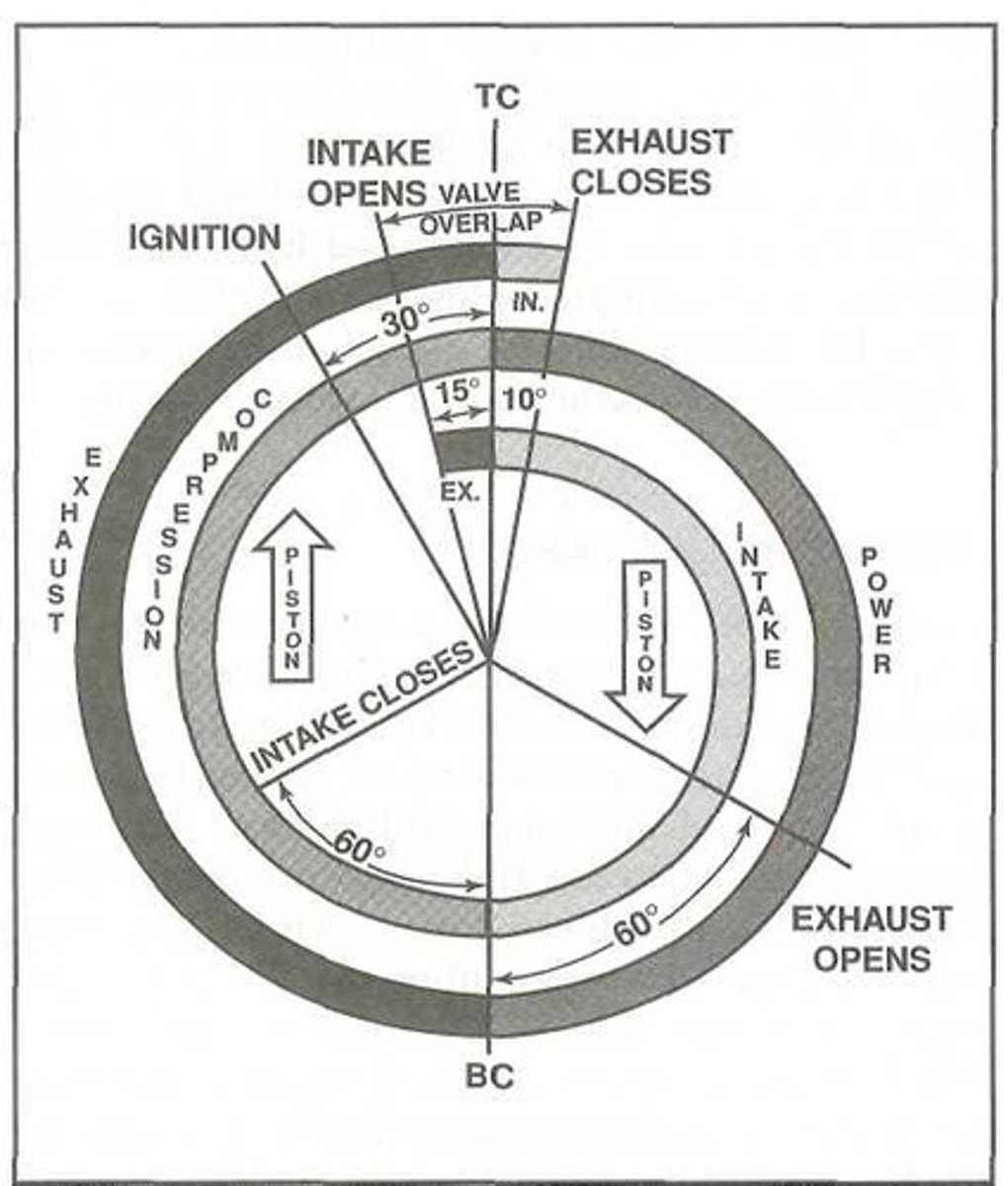
The linear distance a piston travels for a given degree of crankshaft rotation varies from top center to bottom center.
In this example, notice that the valve lead and lag is greater near bottom center than it is near top center. The exhaust valve leads bottom center by 60 degrees and the intake valve lags by 60 degrees. On the other hand, when the piston is near top center, the intake valve leads top center by 15 degrees while the exhaust valve lags by 10 degrees. The reason for this is that _________.
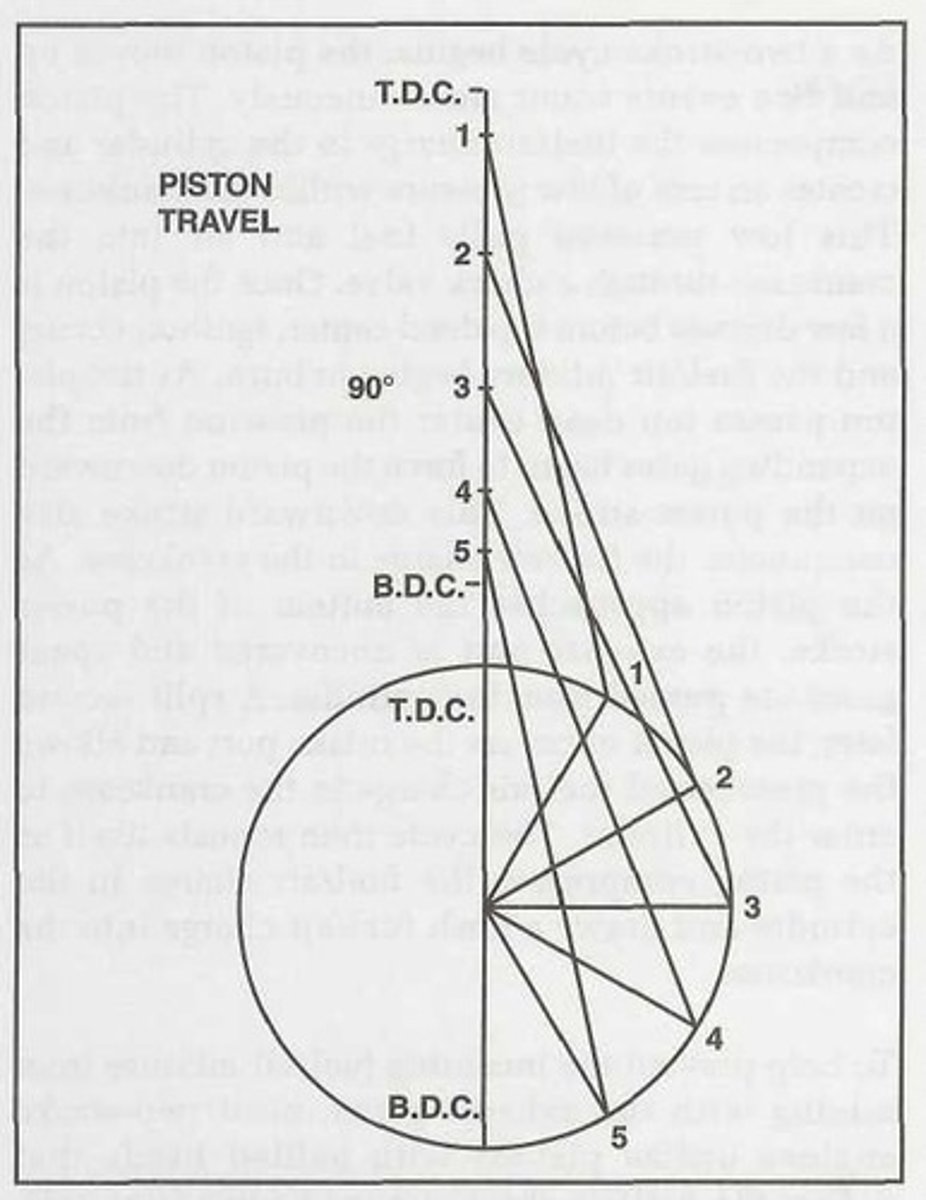
A piston moves more per degree of travel when the piston is near top center than when it is near bottom center.
The circle divided into even segments represents the travel of a crankpin while the vertical line above the circle represents the path of a piston. To represent the connecting rod length, equal length lines are drawn from each segment line to the piston path. From the figure, you can see that ___________.
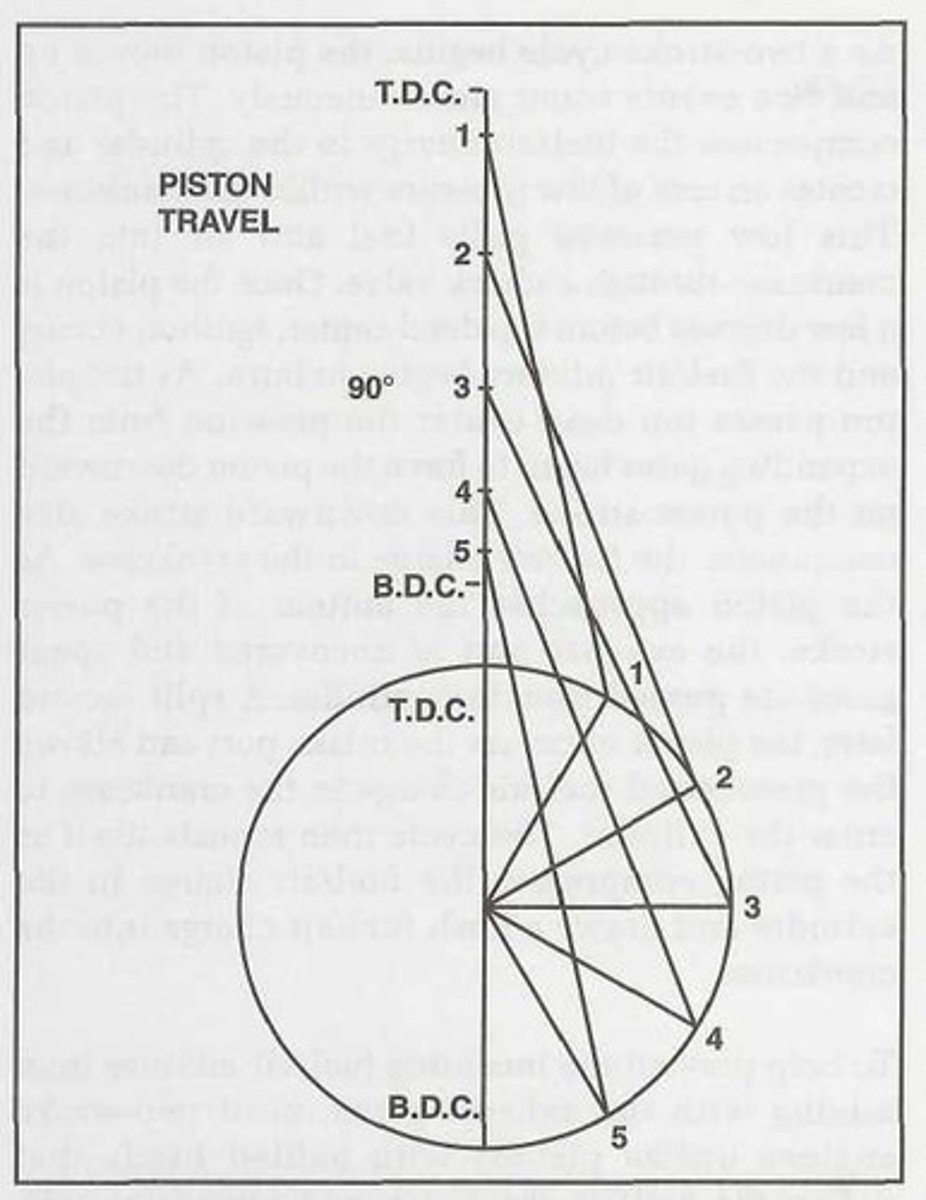
A smoother transition for the piston when it is changing its direction of travel.
As you can see, a piston moves further in the first 90 degrees of rotation than in the second 90 degrees. In addition, piston velocity is highest at the 90 degree point and lowest at top and bottom center positions. This reduction in speed at both top center and bottom center provides ______________.
Valve duration
It is the amount of time the valve is open.
15 degrees to reach top center, 180 degrees to reach bottom center, and then 45 degrees past bottom center for a total of 240 degrees of rotation.
Given an intake valve that opens 15 degrees before top dead center and closes 45 degrees after bottom dead center, the piston travels ___________.
70 degrees to reach bottom center, 180 degrees to reach top center, and then an additional 10 degrees past top center for a total duration of 260 degrees.
If an exhaust valve opens 70 degrees before bottom dead center and closes 10 degrees after top dead center, the piston travels ______________.
The number of degrees between the point where the intake valve closes and the point where the exhaust valve opens.
To determine how many degrees a crankshaft will rotate with both valves closed, or seated, you must determine ___________.
The degree of travel with both valves seated is 245 degrees.
Given that the intake valve closes 45 degrees after bottom dead center on the compression stroke and the exhaust valve opens 70 degrees before bottom center on the intake stroke, the degree of travel with both valves seated is, ______________.
Firing order
An engine's ________ represents the sequence in which the ignition event occurs in different cylinders.
Maintain balance and reduce vibration.
Each engine is designed with a specific firing order to ______________.
Caution should be exercised and manufacturer's maintenance instructions followed carefully.
A four cylinder Continental model O-200-A has a firing order of 1-3-2-4. By the same token, a four cylinder Lycoming model O-320-E3D has the same firing order, but the cylinders are numbered differently. For this reason, ________________.

1-3-5-7-2-4-6
In radial engines, the firing order must follow a specific pattern that allows the power impulses to follow the motion of the crank throw during rotation. For example, on all single-row radial engines, the odd numbered cylinders fire in succession first, followed by the even cylinders. Therefore, the firing order on a seven cylinder radial engine is _____________.
1-3-5-7-9-2-4-6-8
In radial engines, the firing order must follow a specific pattern that allows the power impulses to follow the motion of the crank throw during rotation. For example, on all single-row radial engines, the odd numbered cylinders fire in succession first, followed by the even cylinders. Therefore, the firing order on a nine cylinder radial engine is _____________.
When a cylinder fires in one row, its opposite cylinder must fire in the second row. The power pulses must then go back and forth between rows in alternating cylinders.
Like the single-row, for double-row radial engines, the power pulses must occur between alternate cylinders in each row, in sequence. To balance the power pulses between the two rows, ______________.
1-10-5-14-9-4-13-8-3-12-7-2-11-6
Consider a 14 cylinder double-row radial engine, consisting of two rows of seven cylinders each. The number 10 cylinder is opposite the number 1 cylinder. If the number 1 cylinder fires in the back row, the firing order would be _______________.
1-10-5-14-9-4-13-8-3-12-7-2-11-6
A method for computing the firing order of a 14 cylinder, double-row radial engine is to start with any cylinder number, 1 through 14 and either add 9 or subtract 5, whichever results in a number between 1 and 14. For example, if you start with the number 1 cylinder, 5 cannot be subtracted to arrive at a number between 1 and 14, so you add 9 to arrive at 10. Then, since you cannot add 9 to 10 without exceeding 14, you need to subtract 5 to arrive at 5. Now, add 9 to 5 to get 14, and subtract 5 from 14 to get 9. Continue this pattern until you have the complete 14 cylinder firing order. The answer is _______________.
1-12-5-16-9-2-13-6-17-10-3-14-7-18-11-4-15-8
To determine the firing order of an 18 cylinder, double-row radial engine, the numbers 11 and 7 are used. Begin with any cylinder number from 1 to 18 and either add 11 or subtract 7, whichever will result in a number between 1 and 18. The answer is ______________.
Two-stroke cycle
It is similar to the four-stroke cycle in that the same five events occur in each operating cycle. However, the five events occur in two piston strokes rather than four strokes. This means that one cycle is completed in one crankshaft revolution.
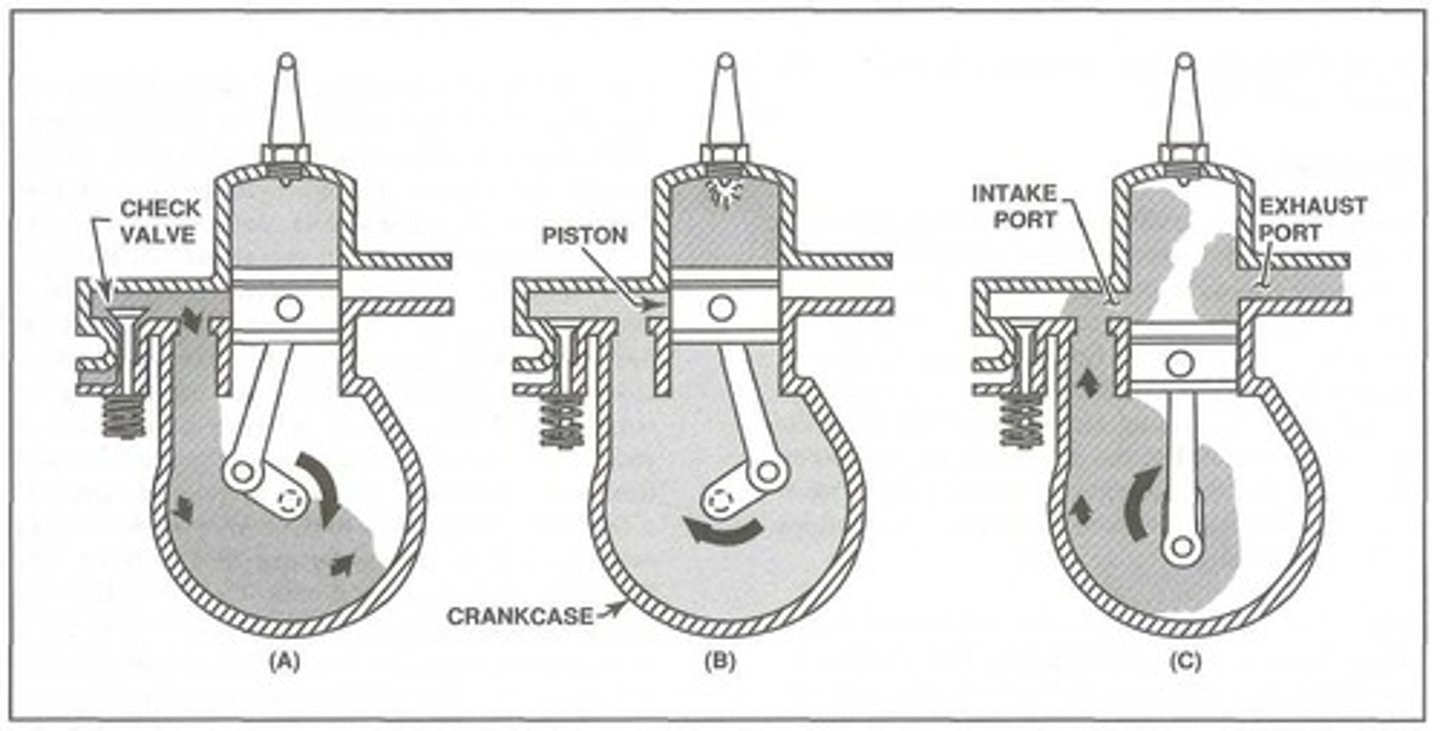
Baffled
To help prevent the incoming fuel/air mixture from mixing with the exhaust gases, most two-stroke engines utilize pistons with _______ heads that deflect the fuel/air charge upward away from exiting exhaust gases.
Reduces the engine's overall efficiency.
Baffled heads do not completely eliminate the mixing problem. Since both the exhaust and intake events take place almost simultaneously, some of the fuel/air charge becomes diluted by the exhaust gases and some is discharged out the exhaust port before being compressed and ignited. This __________.
Eliminates the need for an oil sump which greatly reduces a two-stroke engine's weight.
Lubrication for a two-stroke engine is typically provided by the fuel/air mixture as it circulates in the crankcase. However, the fuel alone does not provide the lubrication. Instead, oil is typically added to the fuel when the fuel tank is filled. This _______________.
It is less efficient and more difficult to cool than the four-cycle engine.
The extreme simplicity and light weight of a two-stroke cycle engine make it useful for such applications as chain saws, lawn mowers, and ultralight aircraft. However, the two-stroke engine's use is limited for aviation applications because _______________.
Work (W)
Force (F) x Distance (D)
Foot-pound (ft-lb)
In the English system, work is typically measured in ________.
Foot-pound (ft-lb)
It is equal to one pound of force applied to an object through the distance of one foot.
Joule (J)
In the metric system, the unit of work is the _____.
Joule (J)
It is the work done by a force of one newton acting through a distance of one meter.
Pound-force (lbf)
It is equivalent to 4.448 newtons.
Power
It is defined as the time-rate of doing work

Foot-pound per second (ft-lb/s)
In the English system, power is expressed in _____________.
Joule per second (J/s)
The unit of power in the metric system is _____________.
Power
When rating engines, it is a primary consideration because it represents how quickly an engine-propeller combination can respond to power demands.
Power
It is a critical factor when determining whether or not an engine can deliver the force needed to produce a specific amount of work in a given time.
Horsepower
Another unit of measure for power. It was first used by James Watt to compare the performance of his steam engine with a typical English dray horse.
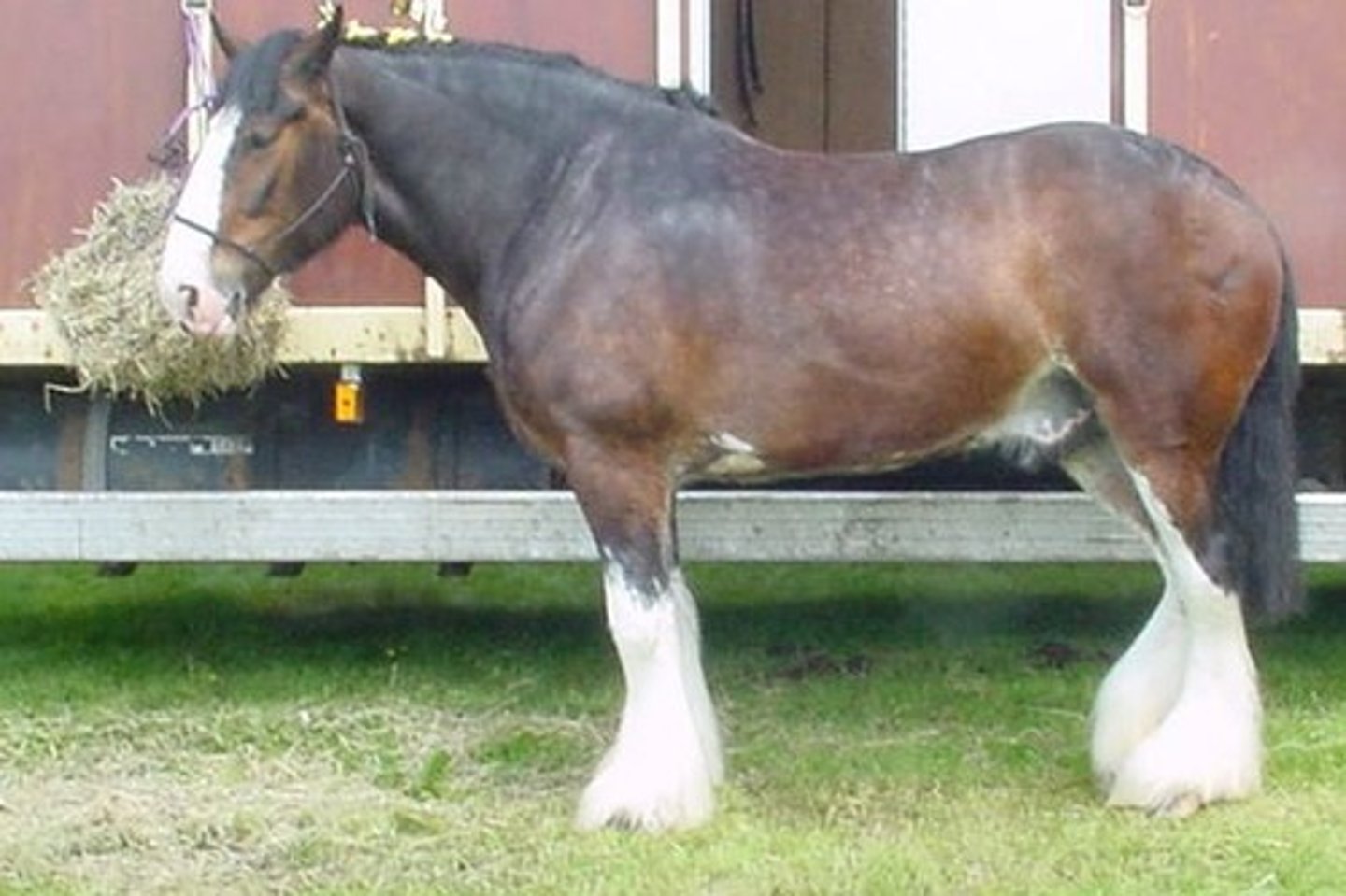
Horsepower
It is the amount of power required to do 33,000 foot-pounds of work in one minute or 550 foot-pounds of work in one second.

Indicated horsepower (IHP)
It is the total power actually developed in an engine's cylinders without reference to friction losses within the engine.
Indicated mean effective pressure (IMEP)
To calculate indicated horsepower, the average effective pressure within the cylinders must be known. One way to determine the effective pressure is to attach a mechanical indicating device to the engine cylinder that records the actual pressure existing in the cylinder during a complete operating cycle. From this data, an average pressure is computed. This average pressure is referred to as ________________.

Indicated mean effective pressure (IMEP) inside the cylinder during a power stroke.
In the formula shown, the letter P indicates _________.

The length of the stroke in feet or fractions of a foot.
In the formula shown, the letter L indicates _________.

Area of the piston head in square inches.
In the formula shown, the letter A indicates _________.

The number of power strokes per minute for one cylinder.
In the formula shown, the letter N indicates _________.

The number of cylinders on the engine.
In the formula shown, the letter K indicates _________.

255 IHP
Compute the indicated horsepower for a six-cylinder engine that has a bore of five inches, a stroke of five inches, and is turning at 2,750 rpm with a measured IMEP of 125 psi per cylinder.
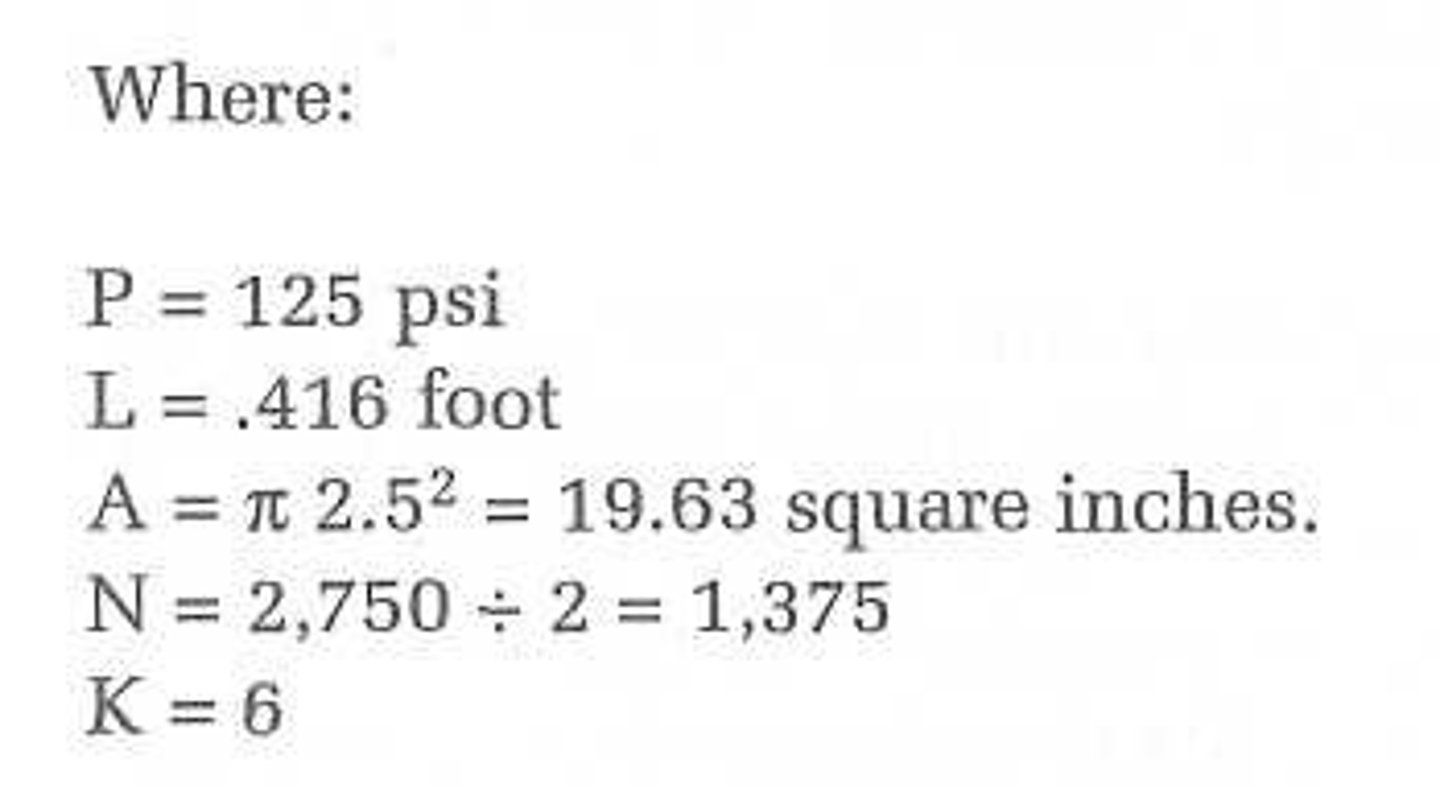
Friction horsepower (FHP)
Not all of the horsepower developed in an engine goes to driving the propeller. The power required to overcome the friction and energy losses is known as ________.
Driving an engine with a calibrated motor and measuring power needed to turn the engine at a given speed.
Friction horsepower is measured by _____________.
Brake horsepower (BHP)
The actual amount of power delivered to the propeller shaft is called _______________.
Indicated horsepower minus friction horsepower (IHP - BHP)
One way to determine brake horsepower by calculation is to ______________.
Torque
In practice, the measurement of an engine's brake horsepower involves the measurement of a quantity known as ______, or twisting moment. It is a measure of load and is properly expressed in pound-inches or pound-feet.
Prony brake dynamometer
Early powerplant design engineers measured brake horsepower using a _______________, which consists of a hinged collar, or brake, clamped to the propeller shaft. The collar acts as an adjustable friction brake. An arm of a known length is rigidly attached to the hinged collar and bears on a set of scales. As the propeller shaft rotates, it tries to spin the brake which, in turn, applies force to a scale. If the resulting force registered on the scale is multiplied by the length of the arm, the resulting product represents the torque exerted by the rotating shaft.
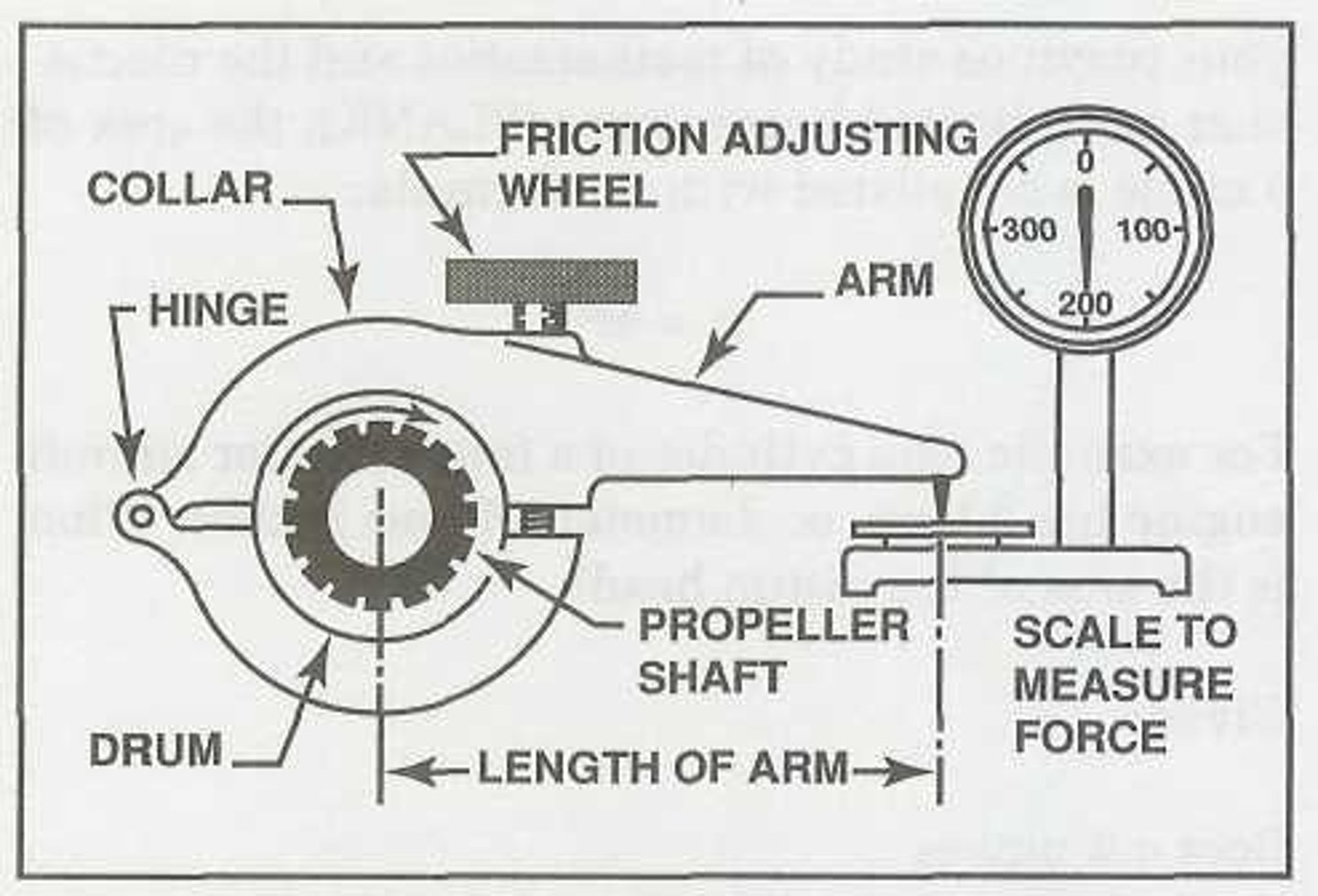
2π x Torque
There are a number of devices that are capable of measuring torque, including the dynamometer and torquemeter. Once the torque is known, the work done per revolution of the propeller shaft is computed using the equation:
Work per revolution multiplied by the rpm which the result would be work per minute or power.
The formula shown is:

Brake horsepower can be computed without knowing the amount of friction between the collar and drum. As long as the torque increase is proportional to the rpm decrease, the horsepower delivered at the shaft remains unchanged.
Which statement is true regarding brake horsepower if the friction between the brake collar and propeller shaft imposes a load without stopping the engine?
Electric/hydraulic dynamometer
Today, the brake horsepower on most modern engines is measured with a/an ______________. With this device, an engine drives an electrical generator. The output of the generator is used to do work, and the amount of work done in a given time is used to calculate the power the engine is producing.
